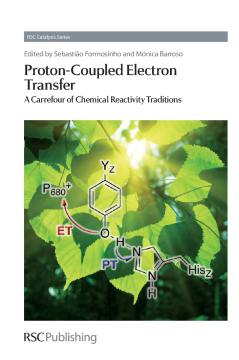
Additional Information
Book Details
Abstract
Proton-coupled electron transfer (PCET) is emerging as an important new class of reactions and, over the past decade, great strides have been made in our understanding of them. PCET reactions are studied in many branches of chemistry and are omnipresent in biological processes. This book covers recent developments from both the theoretical and experimental points of view. It concentrates on the importance of PCET in biological systems and for bioenergetic conversion. The oxidation of water in Photosystem II to produce oxygen, and the reduction of protons to hydrogen by hydrogenase, for energy storage gets particular emphasis. Chemical reactivity is currently explained in terms of several scientific principles. One of them is the bond-breaking-bond-forming process and is conceptually based on potential energy surfaces. Another incorporates the role of Franck-Condon factors resulting from the overlap of vibrational wavefunctions. A third, the so-called solvent reorganization, involves solvent configuration around a charged species. PCET brings together such concepts and links them to quantum mechanical tunnelling of the electron particle. This book uses personal accounts of experimental examples to provide additional insight on this important topic. It starts by presenting a general overview of the main theoretical approaches and experimental applications. The chapters then go on to cover topics including: the application of the Marcus Cross Relation; the solvation of ionic systems; experimental approaches in biological redox systems; metal ion-coupled electron transfer, and electrochemical concerted proton-electron transfers.
"This book will be especially welcomed by scientists who are already familiar with the different aspects of PCET that are treated within it, and it will also be very useful for newcomers."
Ally Aukauloo, ICMMO, Universite Paris-Sud, Paris (France)
"With the help of a well-chosen set of examples, the authors show that a good kinetic model has been developed for HAT reactions based on the Marcus relationship"
Ally Aukauloo, ICMMO, Universite Paris-Sud, Paris (France)
Sebastiao J. Formosinho obtained his Ph.D. from the Royal Institution at the University of London. He later became a Professor of Physical Chemistry, and subsequently the Dean of his Department and of the Faculty of Sciences and Technology at the University of Coimbra. His research interests focus on unidimensional models of chemical reactivity and structure-reactivity relationships. Professor Formosinho has published more than 160 scientific papers and is co-editor / editor of three books and 2 patents. He has also published articles on chemistry teaching and the epistemology of physical sciences. Sebastiao Formosinho is an active member of the Portuguese Academy of Sciences, holds the EUROCHEM title, and is an IUPAC Fellow. He has also been the recipient of a number of professional awards. Mónica Barroso is a postdoctoral researcher at the University of Coimbra, in the group of Photochemistry and Molecular Spectroscopy. Her current research is focused on nanoscale devices for the conversion of solar energy into clean energies. Prior to that, she was based at the EPFL in Switzerland where she started her studies on solar hydrogen generation with nanocrystalline semiconductor photoelectrodes. Other research interests include photochemical reactions in solution, supercritical fluids, proton-coupled electron transfer, and organic-based photovoltaics. She has received 3 research grants from the Portuguese Science Foundation and 2 awards (from Fundação Calouste Gulbenkian and the University of Coimbra).
"the book gives a good insight into current research on a vibrant topic. It is to be expected that it will be the first in a long upcoming list of publications.."
Ally Aukauloo, ICMMO, Universite Paris-Sud, Paris (France)
